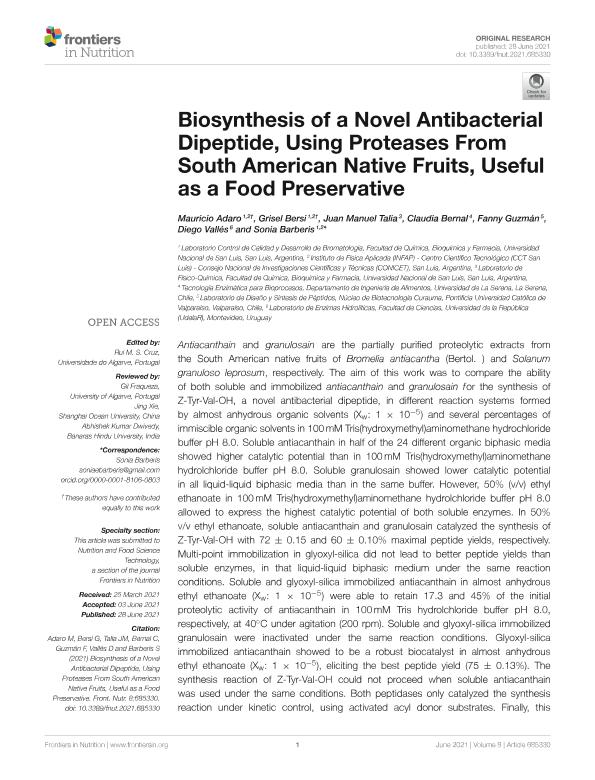Artículo
Biosynthesis of a novel antibacterial dipeptide, using proteases from south american native fruits, useful as a food preservative
Adaro, Mauricio Omar ; Bersi, Grisel
; Bersi, Grisel ; Talia, Juan Manuel
; Talia, Juan Manuel ; Bernal, Cintia Claudia; Guzmán, Fanny; Vallés, Diego; Barberis, Sonia Esther
; Bernal, Cintia Claudia; Guzmán, Fanny; Vallés, Diego; Barberis, Sonia Esther
 ; Bersi, Grisel
; Bersi, Grisel ; Talia, Juan Manuel
; Talia, Juan Manuel ; Bernal, Cintia Claudia; Guzmán, Fanny; Vallés, Diego; Barberis, Sonia Esther
; Bernal, Cintia Claudia; Guzmán, Fanny; Vallés, Diego; Barberis, Sonia Esther
Fecha de publicación:
28/06/2021
Editorial:
Frontiers Media S.A.
Revista:
Frontiers in Nutrition
ISSN:
2296-861X
Idioma:
Inglés
Tipo de recurso:
Artículo publicado
Clasificación temática:
Resumen
Antiacanthain and granulosain are the partially purified proteolytic extracts from the South American native fruits of Bromelia antiacantha (Bertol.) and Solanum granuloso leprosum, respectively. The aim of this work was to compare the ability of both soluble and immobilized antiacanthain and granulosain f or the synthesis of Z-Tyr-Val-OH, a novel antibacterial dipeptide, in different reaction systems formed by almost anhydrous organic solvents (Xw: 1 × 10−5) and several percentages of immiscible organic solvents in 100 mM Tris(hydroxymethyl)aminomethane hydrochloride buffer pH 8.0. Soluble antiacanthain in half of the 24 different organic biphasic media showed higher catalytic potential than in 100 mM Tris(hydroxymethyl)aminomethane hydrolchloride buffer pH 8.0. Soluble granulosain showed lower catalytic potential in all liquid-liquid biphasic media than in the same buffer. However, 50% (v/v) ethyl ethanoate in 100 mM Tris(hydroxymethyl)aminomethane hydrolchloride buffer pH 8.0 allowed to express the highest catalytic potential of both soluble enzymes. In 50% v/v ethyl ethanoate, soluble antiacanthain and granulosain catalyzed the synthesis of Z-Tyr-Val-OH with 72 ± 0.15 and 60 ± 0.10% maximal peptide yields, respectively. Multi-point immobilization in glyoxyl-silica did not lead to better peptide yields than soluble enzymes, in that liquid-liquid biphasic medium under the same reaction conditions. Soluble and glyoxyl-silica immobilized antiacanthain in almost anhydrous ethyl ethanoate (Xw: 1 × 10−5) were able to retain 17.3 and 45% of the initial proteolytic activity of antiacanthain in 100 mM Tris hydrolchloride buffer pH 8.0, respectively, at 40°C under agitation (200 rpm). Soluble and glyoxyl-silica immobilized granulosain were inactivated under the same reaction conditions. Glyoxyl-silica immobilized antiacanthain showed to be a robust biocatalyst in almost anhydrous ethyl ethanoate (Xw: 1 × 10−5), eliciting the best peptide yield (75 ± 0.13%). The synthesis reaction of Z-Tyr-Val-OH could not proceed when soluble antiacanthain was used under the same conditions. Both peptidases only catalyzed the synthesis reaction under kinetic control, using activated acyl donor substrates. Finally, this work reports a novel broad-spectrum antibacterial peptide that significantly decreased (p ≤ 0.05) the specific growth rates of Gram positive and Gram negative microorganisms at very low concentrations (≥15 and 35 μg/ml, respectively); contributing with a new safe food preservative of applying for different food systems.
Archivos asociados
Licencia
Identificadores
Colecciones
Articulos(INFAP)
Articulos de INST. DE FISICA APLICADA "DR. JORGE ANDRES ZGRABLICH"
Articulos de INST. DE FISICA APLICADA "DR. JORGE ANDRES ZGRABLICH"
Citación
Adaro, Mauricio Omar; Bersi, Grisel; Talia, Juan Manuel; Bernal, Cintia Claudia; Guzmán, Fanny; et al.; Biosynthesis of a novel antibacterial dipeptide, using proteases from south american native fruits, useful as a food preservative; Frontiers Media S.A.; Frontiers in Nutrition; 8; 685330; 28-6-2021; 1-15
Compartir
Altmétricas



